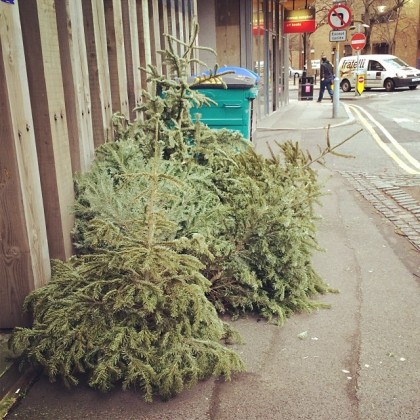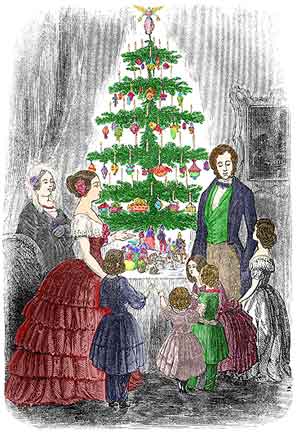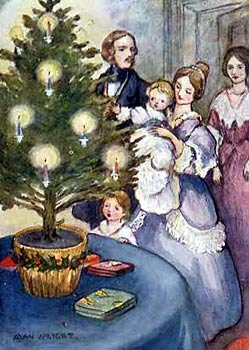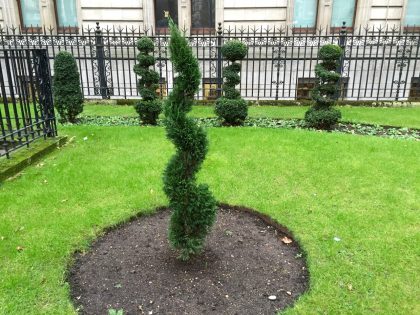Christmas trees are brilliant. However the way they are sold can be a bit wasteful, cost you more money than it should and leave you with a tree that’s lost its needles before you’ve even reached Christmas Eve.
Below I’ve listed a few ways to save you moola, have a gorgeous tree and help save the environment a little bit. It’s my present to you (#cringe). But first, a brief interlude…
Oh Christmas tree, oh Christmas tree :'(

Like everything, growing things is not an infinite commodity. On my RHS Level 2 course I learnt that soil can in fact run out of nutrients, as farmers will confirm. You can replenish it with muck and compost, but it is possible to over farm it to uselessness. Even well managed, sustainable tree farms are probably better left to essentials like furniture.
Something else to think about is the transport involved shipping the 6 million Christmas trees sold in the UK alone. They’re bulky things using lots of petrol to move.
To you they’re expensive. Over the course of three years Christmas trees can cost you anything from £75 – £200. When they should cost you next to nothing.
8 tips for buying a stunning Christmas tree
1) Go potted
A good pot grown tree will hold its needles better because it has roots. Cut trees simply can’t get enough water. They used to have a root system the size of the tree itself.
2) Start smaller
Smaller trees require less transport cost. We all want a splendid tree, and small perfectly shaped ones can be lovely. If placed on a table it can actually be seen and appreciated better.
 3) Be traditional
3) Be traditional
When is a tradition, not a tradition? A Christmas tree as we know it isn’t actually the real, traditional form of tree used. “Until the middle of the nineteenth century the dominant evergreen trees were yew, holly, box and juniper,” says Monty Don in Gardening at Longmeadow (page 330).
Christmas trees began to be shaped by the early Victorians. Back then though, they were modest little things in pots on tables that could be kept safely outside to be used for a few years. Consider using a different tree entirely, go back to the original tradition, dare to be different and stylish.
4) Re-use it
 A tree grown in a pot and looked after over summer will grow bigger each year in your back garden. It will become an old friend welcomed back each time 🙂
A tree grown in a pot and looked after over summer will grow bigger each year in your back garden. It will become an old friend welcomed back each time 🙂
Treat like any pot grown plant. Position and water well, repot in spring to a slightly bigger pot.
You might only have space to do this for a few years, but it will save you a lot of money and you’ll have an increasingly spectacular tree each year!
5) Be real
I love plants and I love Christmas trees! Plastic plants rarely look as natural. They don’t smell or feel the same. The carbon footprint of a plastic tree is ten times that of a real one.
6) Get experiMENTAL

7) Consider topiary
For those of us who want to re-use their Christmas tree year after year with a proper cone shape at the same size, the answer probably lies in topiary.
Topiary is just a plant that can withstand growing in pots and being cut back hard into shape. You can then keep it to size and shape easily.
The obvious first suggestion is yew, apparently actually more traditional than fir. That won’t cut it for most people, especially with young children and pets due to how poisonous it is. Box is a goodun for topiary, but not a conifer obviously. I’ll keep exploring other options and update this article (please add any suggestions below).
8) Grow it
Think of your Christmas tree as a savings scheme. The more years you can keep it going for, the more money you save and the lower your carbon footprint (same tree and no transport cost). For the sake of a tiny bit of watering.




Great article Jack. I hate seeing Christmas trees dumped on the 27th, it breaks my heart.
We have a potted Christmas Tree in our garden that we bring in every year, we’ve had it for three years. We adopted it from a friend who was going to dump it in the New Year. It actually hasn’t grown all that quickly which I think would surprise a lot of people. In the UK they just arrive in their full glory and we buy them without a second thought.